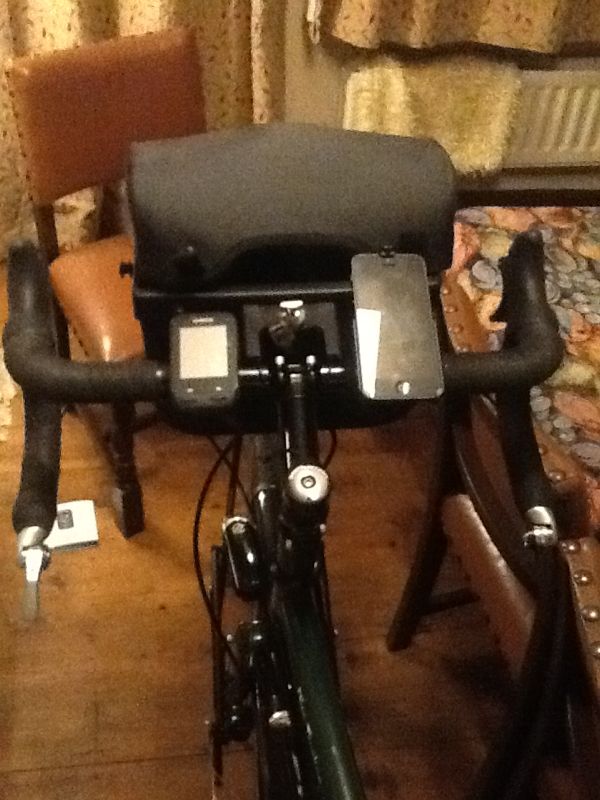From the metropolis of San Francisco, the Western Express Route passes through lush agricultural valleys and climbs over the Sierra Nevada. In Nevada it uses "The Loneliest Road in America," a term coined some years ago by a Life magazine writer. The route then winds among the magnificent monuments and parks of southern Utah. It crosses the spine of the Rocky Mountains over numerous passes to end in Pueblo, Colorado, the gateway to the Great Plains.
This route can be ridden from mid-May through October, depending on weather. Carson Pass crosses over the Sierra Nevada at an elevation of 8,573 feet. Snow can also fall at any time in the Rocky Mountains, and the highest pass is over 11,000 feet. Local conditions and mountain ranges affect winds, so it is difficult to predict any major wind patterns. Dust and sandstorms will occasionally occur in the deserts of Nevada and Utah. Sections 2 and 3 of this route (Nevada and Utah) are considered difficult due not only to steep terrain but also due to lack of water, temperature extremes (as high as 100 degrees Fahrenheit in the summer), and long mileages without services.
After the food and fun of San Francisco by the Bay, a relaxing ferry ride eliminates a hard day of urban cycling and deposits the cyclist in Vallejo. The route parallels an interstate and winds through suburbs to Fairfield and then passes through rolling, verdant agricultural areas before turning east. Urban riding conditions prevail along the section from Davis through Sacramento, Folsom, and Placerville. Separate bike paths, which start in Davis and extend through Sacramento to Folsom, provide welcome relief from busy surface streets. Wineries abound east of Placerville and the route begins to climb the Sierra Nevada foothills to the 8,573 foot Carson Pass. It then descends into the historic mining region around Carson City, Nevada.
People watchers will enjoy a casino visit in Carson City, assuming you don't plan to finance your trip there. Here the route joins U.S. Highway 50 into Fallon, where the challenging part of the route really begins. A dozen climbs await the rider on "The Loneliest Road in America" as it traverses the roller-coaster range and basin country paralleling the route of the famous Pony Express. Nevadans are noted for their self-reliance, hospitality (as long as you are not a federal employee), and whimsical sense of humor as evidenced by such unique attractions as the "shoe tree" and the "Post Impressionist " (fence post) art between Baker and Lehman Cave in Great Basin National Park.
East of Cedar City, Utah, the route passes through some of the nation's most isolated communities and several of its most spectacular scenic wonders. Take some time to explore Cedar Breaks, Escalante, and Natural Bridges National Monuments; Bryce Canyon and Capitol Reef National Parks; and Glen Canyon National Recreation Area. To even the most experienced of travelers, these natural sculptures, spires, buttes, and canyons are no less than humbling. The Utah portion of the route could be a worthy destination in itself. After passing through the bean-growing capital of the nation in southwestern Colorado, the route swings north and then east through the small tourist communities of the Rockies where one can always find an espresso and a ski hill, however modest. The route traverses forested mountains to Salida and from there into the narrow valley of the Arkansas River to Cotopaxi. Here the route leaves busy U.S. Highway 50 and winds through quiet wooded foothills until reaching Pueblo.
Terrain
The route lets you warm up for 150 miles before the first major climb over Carson Pass at 8,573 feet. Nevada offers almost unlimited sight lines across wide valleys before ascending and descending a pass into the next valley. The terrain through central Utah becomes steeper, with grades varying from 6 percent to 14 percent. In Colorado the route follows several river valleys, though for the most part you'll be either climbing or descending.
Logistics
While California is almost urban in availability of services, Nevada and Utah present special problems in obtaining water and food on a daily basis. Carrying a water filter is strongly advised for water access at miscellaneous reservoirs, creeks, and lakes at primitive campsites. In most cases, there are no homes or ranches between services. Call ahead to verify any services. Nevada and Utah are extremely dry, and few trees are available for shade. In Colorado, services are more easily found, though higher altitude services -- from campground water to grocery stores -- can close early depending on weather.
|
1 Comment
First exercise of the year today. Took my bike to the bike shop in Bath to have dynamo hub fitted. Luckily they need it overnight so I don't have to ride home after. Phew. Those hills are a killer. Better keep training if I'm going to manage the Rockies!
|

 RSS Feed
RSS Feed
